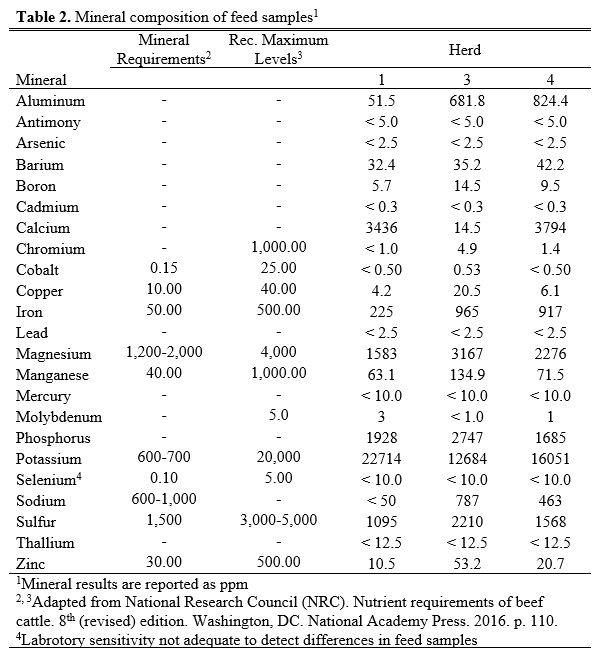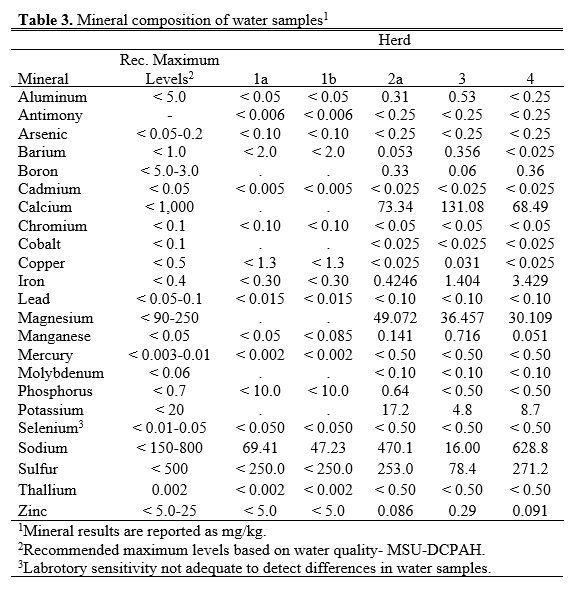2016 Annual Report for GNC15-202
Effects of Pre-breeding Administration of Injectable Trace Mineral Supplements on Subsequent Reproductive Performance in Beef Herds
Summary
The purpose of this project is to evaluate the effects of an injectable trace mineral supplement administered prior to breeding on reproductive parameters including pregnancy rates, calving distribution, and calf weaning weights. A total of 5 commercial beef cattle operators were selected by their local North Dakota State University county extension agents to participate in this research effort. Cooperating producers included Thorne Ranch, Watford City, ND, Hoff Ranch, Dickenson, ND, Schultz Ranch, Sheldon, ND, Ruland Ranch, New Town, ND, and Roise Ranch, Powers Lake, ND. Prior to involvement, telephone conversations were had with each producer to explain project details, detail producer involvement, and answer any questions. Within herd at each location, cows were stratified by days postpartum, then randomly assigned to receive one of two treatments: 1) Cows received no additional treatments prior to bull turnout (CON; n = 638) or 2) Cows were administered an injectable trace mineral supplement (60, 10 and 15 milligrams per milliliter (mg/mL) of zinc, manganese and copper as disodium EDTA chelates, and 5 mg/mL of selenium as sodium selenite) subcutaneously 30 d before bull turnout (TM; n = 673). On the day of mineral administration, blood samples were collected from a random sample of females (n = 37; 8 to 10 females per herd) immediately prior to mineral injection via jugular venipuncture and were analyzed for baseline mineral status. Total mixed rations were collected for the animals still in confinement prior to pasture/bull turnout and water samples were collected from all available water sources for each herd.
Preliminary results from cohort 1 indicated that there was no difference (P = 0.36) in the pregnancy rates of females between groups (TM: 92.0% and CON: 92.9%). Weaning weights of calves at the sides of their dam at the time of treatment administration were also similar (P = 0.90). When evaluating the distribution of calves born in the calving season by 21-d increments, the proportion of calves born in the first 21, 22 to 42, or more than 42 d of the calving season were similar (P = 0.40) between groups.
Blood, feed, and water samples were collected. No differences (P = 0.128) were observed in the blood mineral levels between treatments for cobalt, copper, iron, manganese, molybdenum, selenium, or zinc before treatment administration.
Objectives/Performance Targets
- Document the effects of trace mineral supplements on reproductive performance in commercial beef herds.
- Protocol
- One thousand, three hundred and eleven postpartum beef cows (Herd 1: n = 146; Herd 2: n = 501; Herd 3: n = 460, and Herd 4: n = 204) were stratified within herd by d postpartum, then randomly assigned to receive one of two treatments: 1) Cows received no additional treatments prior to bull turn out (CON; n = 638); or 2) Cows were administered 6 mL of an injectable trace mineral supplementation (60, 10, and 15 mg/mL of zinc, manganese, and copper, as disodium EDTA chelates, and 5 mg/mL of selenium as sodium selenite) subcutaneously on d -30 relative to bull turn out (TM; n = 673).
- Natural service bulls were turned out to all cows 30 d after treatment administration and remained with cows for the duration of the producer defined breeding season. Transrectal ultrasonography or rectal palpation was used to determine the presence of a viable fetus at least 30 d after the end of the breeding season by a herd veterinarian. Calf weaning weights were collected at the time of weaning for the year of administration to determine if any effects of injectable trace mineral supplementation administered to the cow affected the weight of the calf at her side. At the time of calving, birth date and calf sex were recorded.
- Progress
- Preliminary results: As of December 2016, preliminary analysis of data indicate that pregnancy rates did not differ (P = 0.36) between groups of females in the CON and TM groups. Weaning weights of calves on the side of cows receiving treatments also were similar (P = 0.90). At calving, mean calving date was not different (P = 0.99) for those calves born from TM cows or control cows. When evaluating the distribution of calves born in the calving season by 21-d increments, the proportion of calves born in the first 21, 22 to 42, or more than 42 d of the calving season were similar (P = 0.40) between groups.
- Protocol
- Increase producer, extension personnel, and veterinarian knowledge and awareness of mineral status, around the state of North Dakota, generated by the interpretation and reports of the baseline mineral samples.
- Protocol
- On d -30 relative to bull turnout, blood samples were collected from a subset of eight to 10 cows within each herd. Blood was collected via jugular venipuncture for analysis of baseline mineral status. Blood samples were analyzed for concentrations of cobalt (Co), copper (Cu), iron (Fe), manganese (Mn), Molybdenum (Mo), selenium (Se), and zinc (Zn).
- Samples of total mixed rations were collected and placed in bags for herds 3 and 4 while supplemented hay samples were collected for herd 1, representing the animals still in confinement prior to pasture/bull turn out. Water samples were also collected from any and all available water sources for each herd.
- Progress
- Blood, feed, and water samples have been collected. No differences (P = 0.128) were observed in the blood mineral levels between treatments for cobalt, copper, iron, manganese, molybdenum, selenium, or zinc before treatment administration. Herd blood values averages, water samples, and feed samples values are included in the following tables.
- Protocol
- Measure the change in management considerations (i.e. changes in mineral supplementation, use of injectable products, etc.), and the quality of life of those cooperating producers.
- Protocol
- These measurements will be evaluated with the use of survey based questionnaires focusing on learning and behavior based evaluations. Surveys will include before and after type questions as well as assessments of actions or management strategies employed after year one of the project is complete. Producers will be the targeted audience for this type of evaluation as the producers may likely have the ability to increase profitability.
- Progress
- Survey questions are in the process of being created for distribution to cooperating producers.



- NCR-SARE Tables
- Survey questions are in the process of being created for distribution to cooperating producers.
- Protocol
Accomplishments/Milestones
To date, treatments have been applied at 5 operations in North Dakota. At each operation, blood, feed, and water samples have been collected. Producer data including calving information and weaning weights are still being collected. Similarly, objectives 2 and 3 are not yet completed as an extension bulletin will be created based on baseline mineral levels as well as survey data based on producer involvement.
Collaborators:
Assistant Professor, Beef Cattle Research Specialist
1300 Albretch Blvd
Fargo, ND 58102
Office Phone: 7012315588
Extension Agent
201 5th St. NW, Suite 525
Watford City, ND 58854
Office Phone: 7014443451